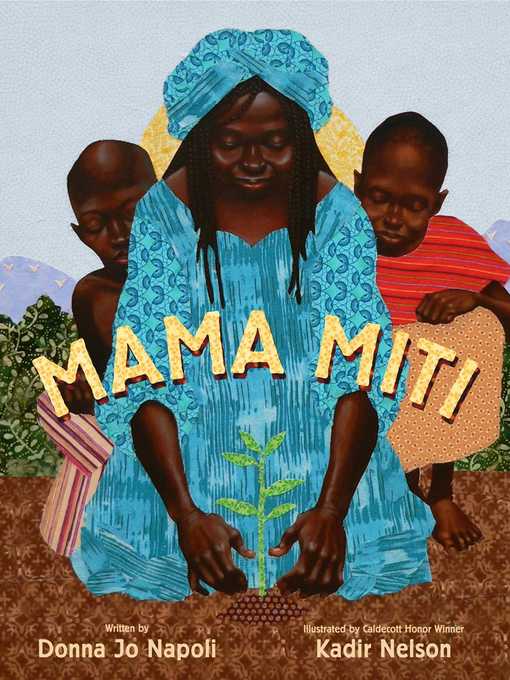
Mama Miti
Wangari Maathai and the Trees of Kenya (with audio recording)
فرمت کتاب
ebook
تاریخ انتشار
2012
Lexile Score
610
Reading Level
2-3
ATOS
4.5
Interest Level
K-3(LG)
نویسنده
Kadir Nelsonشابک
9781442459021
کتاب های مرتبط
- اطلاعات
- نقد و بررسی
- دیدگاه کاربران
نقد و بررسی

Starred review from December 7, 2009
While Nobel Medalist Wangari Maathai has been the subject of two earlier picture biographies (Jeanette Winter's Wangari's Trees of Peace
and Claire Nivola's Planting the Trees of Kenya
), this story is structured more like a folktale, portraying Maathai as healer and botanist. “These are strong hands,” she tells a woman who does not have enough food to feed her family. “Here are seedlings of the mubiru muiru
tree.... Plant as many as you can. Eat the berries.” Nelson's (We Are the Ship
) breathtaking portraits of Maathai often have a beatific quality; bright African textiles represent fields, mountains, and Maathai's beloved trees. Maathai knows that some trees make good firewood, others form hedges to keep livestock safe, while the roots of others clean dirty water. After every encounter, a Kikuyu expression is repeated: “Thayu nyumba—Peace, my people.” Mama Miti, as Maathai comes to be known (it means “mother of trees”), is rewarded not with fame or power but with the satisfaction of seeing Kenya restored. Napoli (The Earth Shook
) creates a vivid portrait of the community from which Maathai's tree-planting mission grows. Ages 4–8.

February 1, 2010
Gr 3-4-This idealistic account focuses on Wangari's wisdom in advising women to plant different kinds of trees to solve their particular economic problems. "Here are seedlings of the "mukinduri". This tree makes good firewood." "Plant a tree. A "mukawa". Its thorns will keep out predators." Napoli inserts a Kikuyu phrase and its translation after each bit of Wangari's advice. ""Thayu nyumba"""Peace, my people." The story seems to suggest that the trees were a rather quick solution to the people's problems of hunger and poverty in Kenya's devastated landscape. "Soon cool, clear waters teemed with black, wriggling tadpoles]. All over the countryside the trees that had disappeared came back." Nelson depicts the various women and the greening of the landscape in bold collages of textile prints joined with strong painted portraits. The poetic, abbreviated story has little biographical detail, emphasizing the planting of millions of trees and the resulting prosperity and peace for the country and its people. The preface describing the ill effects of earlier drought and the broad sweep of text provide less concrete information and explanation than Claire A. Nivola's "Planting the Trees of Kenya" (Farrar) and Jeanette Winter's "Wangari's Trees of Peace" (Harcourt, both 2008). The information is too vague for primary grade children, and probably too skimpy for older grades. Still, the book could serve as a beautiful introduction for children just learning about the Greenbelt Movement. Concluding materials include an afterword for adults, a source note, a Kikuyu glossary, a list of Web sites most useful for adults, and a brief note from the illustrator."Margaret Bush, Simmons College, Boston"
Copyright 2010 School Library Journal, LLC Used with permission.

February 15, 2010
Grades K-3 Luminous illustrations are the highlight of this third recent picture-book biography of Wangari Maathai, the Kenyan environmental activist who received the 2004 Nobel Peace Prize. In brief, poetic lines that have a folktale tone, Napoli describes how wise Wangari helped Kenyan village women solve problems from hunger to dirty water with the same solution: Plant a tree. Eventually, Maathais Green Belt movement became a worldwide mission. Jeanette Winters Wangaris Trees of Peace: A True Story from Africa and Claire A. Nivolas Planting the Trees of Kenya: The Story of Wangari Maathai (both 2008) integrate more background context, and readers encountering Maathais story for the first time here will need to start with the appended short biography in order to understand the storys generalized references. Most noteworthy is Nelsons vibrant collage artwork, which features soaring portraits and lush landscapes in oil paint and printed fabrics. An authors note about sources and a glossary of Kikuyu and Swahili words used throughout the text close this moving tribute, which will partner well with Winters and Nivolas titles.(Reprinted with permission of Booklist, copyright 2010, American Library Association.)

























دیدگاه کاربران